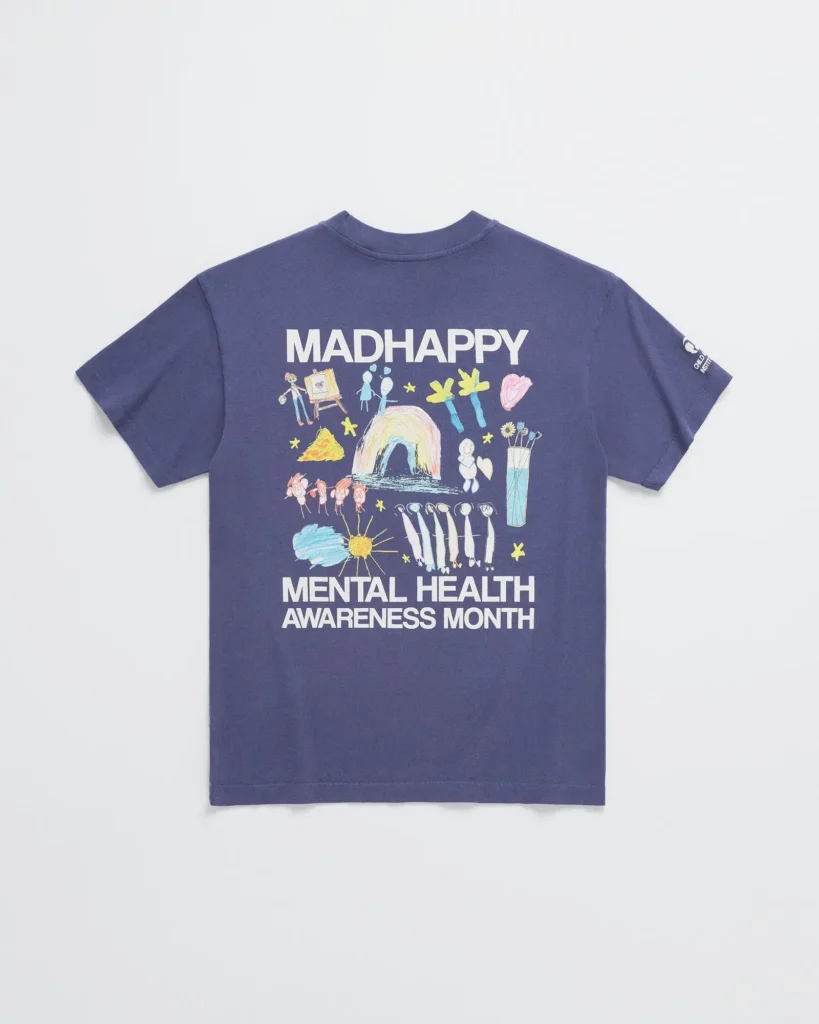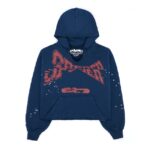The Origins of a Movement: How Mad Happy Began
In an age where fashion and authenticity often collide, few brands have managed to carve out a space that feels both trendsetting and deeply meaningful. Mad Happy is one of those rare exceptions. Founded in 2017 by four young visionaries—Peiman Raf, Noah Raf, Mason Spector, and Joshua Sitt—Mad Happy wasn’t just built to sell clothing. It was created to spark conversation, spread optimism, and challenge the way society discusses mental health.
The name itself, “Mad Happy,” is a paradox that reflects the emotional complexity of modern life. It’s an honest admission that life isn’t always perfect, and that’s okay. The brand’s purpose was rooted in destigmatizing mental health by encouraging openness and vulnerability—qualities rarely associated with the stoic exterior of the fashion industry. With backgrounds in marketing, business, and a shared passion for streetwear, the founders united to build something greater than just a label—they built a community.
The Brand Philosophy: Optimism Meets Realism
At its core, Mad Happy is driven by a profound philosophy: blending optimism with realism. The founders recognized that mental health conversations were often overly clinical or avoided altogether. So they decided to approach it differently—through the universal language of fashion. Streetwear, with its deep cultural roots and massive youth appeal, became the perfect medium for connection.
Rather than masking emotion, Mad Happy encourages expression. Their clothing often features uplifting messages, bold colors, and conversation-starting slogans like “Local Optimist” and “Mental Health is Health.” These aren’t just trendy phrases; they’re intentional tools meant to uplift, engage, and encourage wearers to talk about how they’re truly feeling. In a world often obsessed with curated perfection, Mad Happy’s honesty is refreshing. It resonates with a generation that values both style and substance.
Breaking the Streetwear Mold
Streetwear has traditionally been synonymous with exclusivity, hype drops, and an aesthetic rooted in rebellion and cool detachment. Mad Happy took that framework and flipped it on its head. While still embracing limited releases and high-quality designs, they infused their collections with positivity and purpose. This approach didn’t alienate the traditional streetwear crowd—instead, it expanded the definition of what streetwear could be.
Mad Happy’s pieces aren’t designed just to make a statement on the outside, but to evoke introspection and self-awareness on the inside. Hoodies with affirmations, sweatshirts that speak to shared human experiences, and collections inspired by therapy, mindfulness, and emotional growth—these elements redefine the consumer-brand relationship. The message becomes the medium, and the clothing becomes a vehicle for social impact.
The Design Aesthetic: California Cool Meets Mindful Minimalism
Mad Happy’s visual identity draws heavily from its Los Angeles roots. The designs are sun-soaked, casual, and deeply wearable, yet imbued with meaning. Pastel color palettes, oversized silhouettes, and text-based graphics make their garments easily recognizable but never overbearing. There’s a calming quality to their design language—each piece feels intentional and personal.
They often collaborate with artists, creatives, and wellness practitioners to develop collections that reflect a broad spectrum of human emotion. Whether it’s a hoodie in a sky-blue shade named “Serenity” or a graphic tee that reads “It’s Okay to Feel,” every design choice is an extension of the brand’s deeper message. It’s fashion that feels good, both aesthetically and emotionally.
Community as the Cornerstone
One of Madhappy Hoodie greatest strengths is its ability to build community. From the start, the founders understood that their message couldn’t exist in a vacuum. So they focused heavily on creating a brand that felt inclusive, approachable, and real. This isn’t a brand that only cares about selling out drops—it cares about who’s wearing them, and why.
Through pop-up shops across the U.S., Mad Happy has curated spaces for conversation, creativity, and connection. These aren’t just retail locations—they’re community hubs. Inside, visitors find cozy interiors with mental health resources, journaling stations, and interactive installations. It’s not uncommon to walk into a Mad Happy event and leave with a deeper understanding of yourself or a new friend who’s just as open about mental health as you are.
They also host panel discussions, wellness workshops, and fundraisers. These activations aren’t side projects—they’re integral to the Mad Happy mission. The brand is constantly thinking beyond the garment, seeking new ways to impact lives directly and meaningfully.
The Local Optimist Group: More Than Merch
In 2020, Mad Happy formalized its mental health efforts through the creation of the Local Optimist Group, a nonprofit initiative under the brand’s umbrella. The organization focuses on spreading education, funding mental health programs, and increasing awareness through research and community partnerships.
The Local Optimist Group supports groundbreaking studies and partners with institutions like the University of Michigan to explore how early intervention and education can improve mental health outcomes for young people. They’ve also launched digital platforms and resources to give people the tools they need to start their mental health journey.
Unlike brands that simply tack on philanthropy as a PR tactic, Mad Happy’s entire business model revolves around this mission. A portion of proceeds from each drop is donated to mental health causes, making every purchase an act of support.
Collaborations That Elevate the Mission
In the world of fashion, collaborations are often driven by hype or visibility. But Mad Happy has taken a different path, partnering only with brands and figures that align with their values. Their collaborations with Columbia Sportswear, LVMH, Pixar, and even celebrities like LeBron James have maintained an emphasis on mental health and meaningful storytelling.
One of the most notable collaborations was with Columbia, where the two brands created a line of outdoor-ready gear designed to encourage mindfulness in nature. The collection wasn’t just stylish—it included messages about taking time to disconnect, recharge, and reconnect with the self. Each piece reminded wearers of the importance of balance, resilience, and reflection.
These collaborations extend Mad Happy’s reach without diluting its essence. By aligning with partners who share their vision, they amplify their message while staying true to their roots.
Mental Health and Gen Z: Why Mad Happy Resonates
It’s no coincidence that Mad Happy found a devoted following among Gen Z. This is a generation defined by openness, digital awareness, and a willingness to challenge traditional norms—especially when it comes to mental health. For many young people, vulnerability is no longer a weakness but a strength. Mad Happy reflects and reinforces that belief.
In an age dominated by social media, where perfection is often prioritized over authenticity, Mad Happy serves as a counterbalance. It gives Gen Z a way to show up in the world with their struggles and triumphs in full view. The brand validates feelings and encourages healthy conversations, all while offering products that look and feel good.
Moreover, Gen Z values brand transparency. They don’t want just another logo—they want meaning. Mad Happy offers that in abundance. From the Local Optimist newsletter to their candid blog posts and intimate social media presence, the brand meets their audience with empathy, openness, and care.
The Future of Fashion with Purpose
Madhappy Tracksuit is more than a trend. It’s a blueprint for what fashion can and should be in the 21st century—a blend of creativity, consciousness, and community. As mental health continues to become a central issue in global conversations, brands like Mad Happy will play a critical role in reshaping cultural narratives.
The fashion industry has long been criticized for promoting unrealistic standards and contributing to mental health issues, especially among young people. Mad Happy offers a countermodel: one that uplifts, educates, and empowers. They’re not just redefining streetwear—they’re reimagining the entire role of fashion in society.
Looking ahead, Mad Happy has the opportunity to expand globally, diversify its product offerings, and deepen its social impact. But if the past few years are any indication, they won’t do so at the expense of their core mission. Every step forward will be measured, intentional, and rooted in the brand’s original goal—to create a world where people feel seen, heard, and supported.
A Brand That Speaks to the Soul
Mad Happy is more than clothes—it’s a cultural shift. It invites people to wear their emotions on their sleeves, to embrace the highs and lows of life, and to support each other in the process. In doing so, it has become a beacon for authenticity in an industry often dominated by illusion.
By staying true to its mission and refusing to conform to outdated norms, Mad Happy has proven that fashion can be a force for good. It’s not about chasing trends—it’s about setting them. It’s not about hiding feelings—it’s about honoring them. In every stitch, slogan, and sweatshirt, Mad Happy asks us to look inward, speak openly, and live optimistically.


